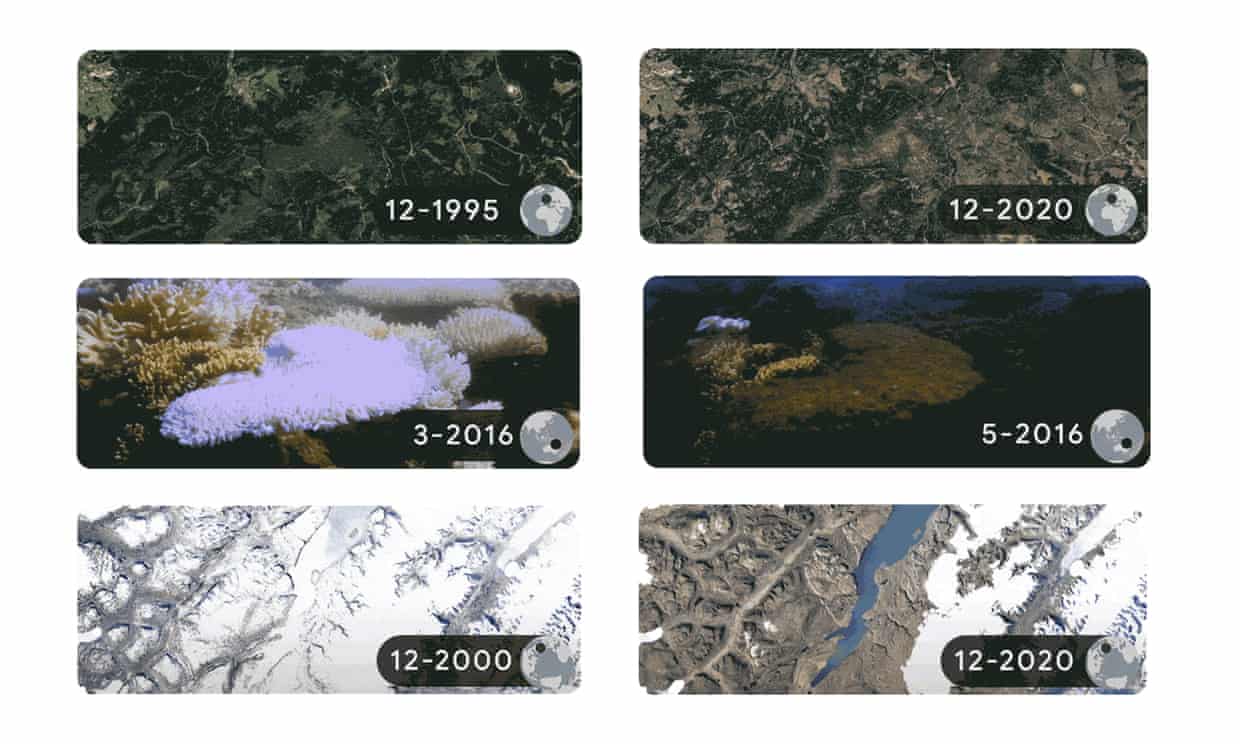Google doodle marks Earth Day 2022 with stark images of climate crisis
Time-lapse satellite images show glacial retreat at Mount Kilimanjaro, Great Barrier Reef coral bleaching, deforestation in Germany and Greenland glacial melt

Thu 21 Apr 2022 23.29 EDT
Last modified on Thu 21 Apr 2022 23.52 EDT"Google is marking Earth Day with time-lapse satellite images showing melting glaciers, retreating snow cover, deforestation and coral bleaching to remind its users about humanity’s impact on the climate and environment.
The 2022 Earth Day Google doodle includes four Gifs created from satellite imagery and photographs from The Ocean Agency that will rotate throughout the day.
Other images show the result of a coral bleaching event on the Great Barrier Reef near Lizard Island in Australia between March 2016 and October 2017 and deforestation of the Harz forests in Elend, Germany, between December 1995 and 2020.
Climate counsellor Lesley Hughes, a professor of biology at Macquarie University in Sydney, said the images of coral bleaching on the Great Barrier Reef are “a very high-impact visual image” that would resonate.
“Our major natural icon, that we are stewards of, is a symbol of the impact of climate change on an extraordinarily diverse ecosystem,” Hughes said.
“Our physical and biological world is transforming before our eyes and that’s what these images are emphasising and so there’s absolutely no time to waste.”
The Great Barrier Reef went through its sixth mass bleaching event in March with aerial surveys showing almost no reefs across a 1,200km stretch escaping the heat – the first known to have occurred during a La Niña year.
Hughes said for those elsewhere, the images of glacial ice retreating would be similarly meaningful.
In New Zealand, the vast and ancient glaciers are thinning at an alarming rate.
The National Institute of Water and Atmospheric Research (Niwa) found that between 1977 to 2014, a third of the permanent snow and ice was lost from the Southern Alps – a dramatic decline that began accelerating rapidly in the last 15 years.
More recently the summer of 2017-2018 brought temperatures 3C warmer than average across New Zealand, shrinking some glaciers so much they all but disappeared.
Elsewhere artefacts long-entombed in the Italian Alps are being revealed as the ice melts, leading to the discovery of equipment left behind by soldiers camped out on the peaks during the first world war and a 5,300-year-old crime scene when the mummified body of Ötzi was found by hikers.
What has been a boon for archaeologists is also a symptom of the catastrophic threat caused by climate change. Forni, one of Italy’s largest valley glaciers, has retreated 800 metres within the past 30 years and 1.2 miles (2km) over the past century.
The images contrast with the positive note struck with the animation published for Earth Day 2021, which the company said was designed to “encourage everyone to find one small act they can do to restore our Earth”.
Hughes said the confronting images published in 2022 may be a response to the IPCC26 report and were important for raising awareness.
“I think when you’re sitting in a middle-class environment and it’s a nice day and the sun’s come up or has gone down, it’s easy to become complacent about the larger forces at work in our climate system and the impacts those forces have,” Hughes said.
“So reminding people that just because it’s a nice day, climate change hasn’t gone away is really important. . ."
Reference >>


No comments:
Post a Comment